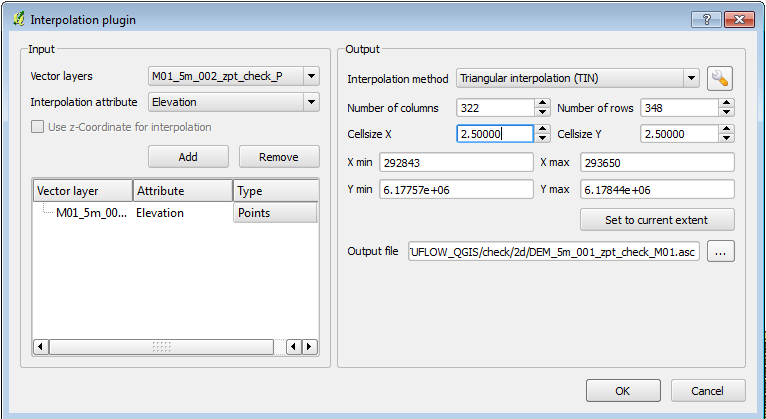Difference between revisions of "QGIS Creating a Grid from Points"
Jump to navigation
Jump to search
(Created page with "=Introduction= In this page a DEM is created from point shapefile containing elevations. For this example the zpt_check file from module 1 of the TUFLOW tutorial model will be us...") |
|||
| Line 14: | Line 14: | ||
<li>Select OK and the interpolation will be processed, this may take a few minutes depending on the number of points.</li> | <li>Select OK and the interpolation will be processed, this may take a few minutes depending on the number of points.</li> | ||
<li>In the properties dialogue, set the Style Colormap to "Pseudocolor" for a quick visualisation, or alternatively set a custom colormap. The grid should appear as below. | <li>In the properties dialogue, set the Style Colormap to "Pseudocolor" for a quick visualisation, or alternatively set a custom colormap. The grid should appear as below. | ||
| + | :'''Tip:''' To enable relief shading see <u>[[QGIS_Relief_Shading | the relief shading tip in the QGIS tips and tricks]]</u>. | ||
[[File:TuteM01 QGIS zpt check 01.png|frame|none]] | [[File:TuteM01 QGIS zpt check 01.png|frame|none]] | ||
</ol> | </ol> | ||
Revision as of 13:32, 25 January 2012
Introduction
In this page a DEM is created from point shapefile containing elevations. For this example the zpt_check file from module 1 of the TUFLOW tutorial model will be used, but the process can apply to any point layer. This is useful for visualising the final elevations for a model simulation from a TUFLOW Zpt Check file.
Method
- Open the desired shapefile in QGIS.
- Select Plugins >>> Interpolation >>> Interpolation from the menu items.
- In the Input section of the Interpolation dialogue, use the drop down list to select the appropriate Vector Layer, select the attribute to interpolate. This is the Elevation attribute if using a check file. Select Add to include this in the interpolation.
- In the Output section of the dialogue:
- Set a interpolation method. For this demonstration a TIN method is used, but feel free to experiment.
- Set the X and Y cell size to an appropriate number (half the cell size if using a zpt_check file).
- Specify the output file name.
- Select OK and the interpolation will be processed, this may take a few minutes depending on the number of points.
- In the properties dialogue, set the Style Colormap to "Pseudocolor" for a quick visualisation, or alternatively set a custom colormap. The grid should appear as below.
- Tip: To enable relief shading see the relief shading tip in the QGIS tips and tricks.
